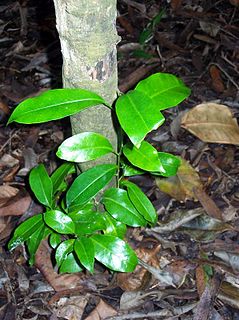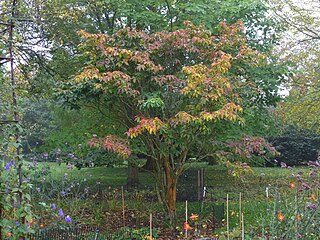
Euphorbia is a very large and diverse genus of flowering plants, commonly called spurge, in the spurge family (Euphorbiaceae). "Euphorbia" is sometimes used in ordinary English to collectively refer to all members of Euphorbiaceae, not just to members of the genus. Some euphorbias are commercially widely available, such as poinsettias at Christmas. Some are commonly cultivated as ornamentals, or collected and highly valued for the aesthetic appearance of their unique floral structures, such as the crown of thorns plant. Euphorbias from the deserts of Southern Africa and Madagascar have evolved physical characteristics and forms similar to cacti of North and South America, so they are often incorrectly referred to as cacti. Some are used as ornamentals in landscaping, because of beautiful or striking overall forms, and drought and heat tolerance.

Malus is a genus of about 30–55 species of small deciduous trees or shrubs in the family Rosaceae, including the domesticated orchard apple – also known as the eating apple, cooking apple, or culinary apple. The other species are commonly known as crabapples, crab apples, crabtrees, or wild apples.

Aleurites is a small genus of arborescent flowering plants in the Euphorbiaceae, first described as a genus in 1776. It is native to China, the Indian Subcontinent, Southeast Asia, Papuasia, and Queensland. It is also reportedly naturalized on various islands as well as scattered locations in Africa, South America, and Florida.

Podocarpus is a genus of conifers, the most numerous and widely distributed of the podocarp family, the Podocarpaceae. Podocarpus species are evergreen shrubs or trees, usually from 1 to 25 m tall, known to reach 40 m (130 ft) at times. The cones have two to five fused cone scales, which form a fleshy, berry-like, brightly coloured receptacle at maturity. The fleshy cones attract birds, which then eat the cones and disperse the seeds in their droppings. About 97 to 107 species are placed in the genus depending on the circumscription of the species.

Antidesma is a genus of tropical plant in the family Phyllanthaceae formally described by Linnaeus in 1753. It is native to tropical Africa, S + E + SE Asia, Australia, and various oceanic islands. The greatest diversity occurs in Southeast Asia.

Carissa is a genus of shrubs or small trees native to tropical and subtropical regions of Africa, Australia and Asia. Until recently about 100 species were listed, but most of them have been relegated to the status of synonyms or assigned to other genera, such as Acokanthera.

Myrica is a genus of about 35–50 species of small trees and shrubs in the family Myricaceae, order Fagales. The genus has a wide distribution, including Africa, Asia, Europe, North America and South America, and missing only from Australia. Some botanists split the genus into two genera on the basis of the catkin and fruit structure, restricting Myrica to a few species, and treating the others in Morella.
Spathiostemon is a genus of trees in the Euphorbiaceae family. It is native to the Bismarck Archipelago, New Guinea, Wallacea and Southeast Asia. The trees grow between 10 and 20m tall, often in secondary forest. The wood is sometimes used.
Shirakiopsis is a genus of flowering plants in the family Euphorbiaceae first described as a genus in 1999. There are six known species, 3 native to tropical Asia and 3 to tropical Africa.

Fontainea is a genus constituting part of the plant family Euphorbiaceae. The nine currently known species grow naturally in Queensland (Qld) and New South Wales (NSW) Australia, New Caledonia and Vanuatu, and Papua New Guinea. Some species are commonly named blushwood.

Neoshirakia, known as milktree, is a genus of plants in the Euphorbiaceae, native to east Asia. It is part of a group first described in 1954 with the name Shirakia, but this proved to be an illegitimate name, unacceptable under the Code of Nomenclature. The genus was later divided, with its species distributed amongst three genera: Neoshirakia, Shirakiopsis, and Triadica. Neoshirakia contains only one known species, Neoshirakia japonica, known as tallow tree, native to China, Korea, and Japan. The name Shirakia thus became a synonym of Neoshirakia because S. japonica was the type species for that genus, the species now renamed N. japonica.

Breynia is a plant genus in the family Phyllanthaceae, first described in 1776. It is native to Southeast Asia, China, the Indian Subcontinent, Papuasia, Australia, and the island of Réunion.
Mallotus plicatus is a tree or shrub in the Euphorbiaceae family, in the Polyadenii section. It occurs in much of Mainland Southeast Asia. It is used for dyeing and in construction.
Mallotus floribundus is a tree in the family Euphorbiaceae, in the Stylanthus section, native to Southeast Asia, Wallaceae, New Guinea and the Solomon Islands.
Spathiostemon javensis is a plant that can grow as a shrub or a tree in the tribe Acalypheae of the family Euphorbiaceae. It is endemic to Malesia, occurring from the Bismarck Archipelago to New Guinea, Wallacea and into Southeast Asia. It is often common in the understorey of forests. The wood is used in constructions.
Spathiostemon moniliformis is a plant that can grow as a shrub or a tree in the Euphorbiaceae family, Acalypheae tribe. It is endemic to southern/peninsular Thailand.
Pimelodendron amboinicum is a tree species in the Euphorbiaceae family. It is found from the Solomon Islands in the southwest Pacific, west to Sulawesi in Indonesia. The timber is used locally, though larger-scale illegal logging is apparent.
Quassia harmandiana is a freshwater mangrove shrub or small tree in the Simaroubaceae family. It is found in Cambodia, Laos and Vietnam. The wood provides firewood. Certain fish eat the poisonous fruit
Aporosa octandra is a species of plant in the family Phyllanthaceae found from Queensland and New Guinea to Indonesia, Zhōngguó/China and India. It is a highly variable plant with 4 named varieties. Its wood is used in construction and to make implements, its fruit is edible. The Karbi people of Assam use the plant for dyeing, textile colours have quite some significance in their culture.
Aporosa tetrapleura is a species of plant in the family Phyllanthaceae found in Cambodia and Vietnam. The wood is used in house and cattle barn construction and as firewood.









